A Cactus Odyssey in Arizona
This article is a pictorial chronicle of my visit to central Arizona with emphasis on the cacti, related succulents
and the surrounding habitat over the short period of three days; May 13 to 15 2006.
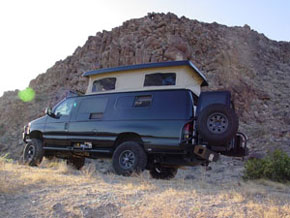 Along with on the trip were my wife, Madolyn and three children Siobhan, Samantha, and Spencer. We left home on Friday May 12, but
the journey really started Saturday morning. We stayed in our 4wd Motorhome/Van Conversion just on the other side of the 10 freeway
from Joshua Tree National Park, California about 60 miles from Palm Springs. I found this spot using the satellite images from
Google Earth and it worked out perfectly. Only a hundred feet or so above sea level, this area was already quite hot considering
it was only the middle of May. The thermometer read 86º F at 6:00 AM when we woke up.
Along with on the trip were my wife, Madolyn and three children Siobhan, Samantha, and Spencer. We left home on Friday May 12, but
the journey really started Saturday morning. We stayed in our 4wd Motorhome/Van Conversion just on the other side of the 10 freeway
from Joshua Tree National Park, California about 60 miles from Palm Springs. I found this spot using the satellite images from
Google Earth and it worked out perfectly. Only a hundred feet or so above sea level, this area was already quite hot considering
it was only the middle of May. The thermometer read 86º F at 6:00 AM when we woke up.
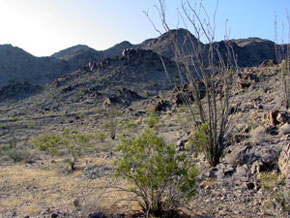 The place we stayed is part of the Colorado Desert of California, named because the Colorado River forms the easter boundary of this desert.
The area where we stayed is on the northern edge of this harsh desert.
The Colorado is a desert among deserts with conditions much more harsh than that of the rest of the Sonoran which it is
a part of. In the early hours of the morning, I took my camera on a short walk around our camp site. The landscape there
consists of the jumbled decomposing granite boulders with sparse vegetation. Scattered Ocotillo (Fouquieria splendens) were in bloom and
occasionally leafed out along with the ever-present Creosote Bush (Larrea tridentata). These plants are the most obvious in an area
where little other vegetation grows.
The place we stayed is part of the Colorado Desert of California, named because the Colorado River forms the easter boundary of this desert.
The area where we stayed is on the northern edge of this harsh desert.
The Colorado is a desert among deserts with conditions much more harsh than that of the rest of the Sonoran which it is
a part of. In the early hours of the morning, I took my camera on a short walk around our camp site. The landscape there
consists of the jumbled decomposing granite boulders with sparse vegetation. Scattered Ocotillo (Fouquieria splendens) were in bloom and
occasionally leafed out along with the ever-present Creosote Bush (Larrea tridentata). These plants are the most obvious in an area
where little other vegetation grows.
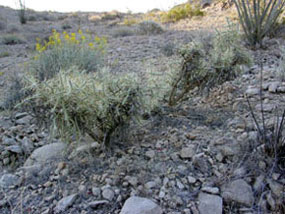 The first cactus I encountered was nearby the place we camped and was the frail-looking, yet extremely hardy Cylindropuntia
ramosissima. This species does also occur in Arizona, Nevada, and Baja California although I did find it later on
in Arizona, I didn't get as nice a picture. The common name for this species is Diamond Cholla which describes the shape of the tubercles when viewed at
close range. I have found C. ramosissima in the wild several times before, but I still have not seen it in bloom. I will
have to make a trip out to the desert earlier in the spring, I think.
The first cactus I encountered was nearby the place we camped and was the frail-looking, yet extremely hardy Cylindropuntia
ramosissima. This species does also occur in Arizona, Nevada, and Baja California although I did find it later on
in Arizona, I didn't get as nice a picture. The common name for this species is Diamond Cholla which describes the shape of the tubercles when viewed at
close range. I have found C. ramosissima in the wild several times before, but I still have not seen it in bloom. I will
have to make a trip out to the desert earlier in the spring, I think.
I also found the remains of Cylindropuntia echinocarpa which had died apparently from lack of water. I wondered
if there was a drought in the area or if the whole climate was gradually getting drier as I've read is happening in different South American deserts.
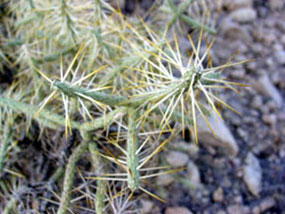
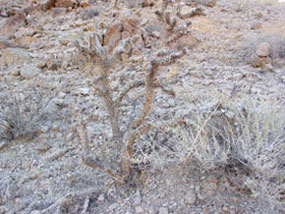
After exploring around this area for a little while, I came back to the van. The coffee had finished brewing so we dropped the top
and got on the I-10 East without stopping again until Arizona. No sooner did we cross the California/Arizona border then we started
seeing Saguaros scattered on the hills. Almost immediately I noticed that they were in bloom! I had never seen Carnegiea gigantea
in bloom before and was elated. Our route was to take us just over 20 miles into Arizona on the 10 and then we split off onto
US highway 60. We only made it about a mile or two down the highway before I had to stop. Saguaro's were on both sides of us.
I got out and headed straight to the closest one I could see and there I took my first pictures of the magnificent white flowers.
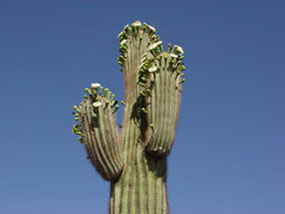
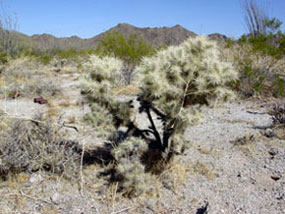
Before going on about the wonderful Saguaros, I want to mention that Cylindropuntia echinocarpa was found here also, but
this time it was very much alive. This is another species that I had not yet seen in bloom. C. echinocarpa is referred to as either
Silver Cholla or Gold Cholla because the spines range in color from shiny white to bright yellow. In Anza-Borrego state park the Silver
form seems to be the most common and in Death Valley National Park where I've also seen them, they appear to be very golden. Here, as you
can see they where somewhere in-between -not the silver-white or the brilliant gold.
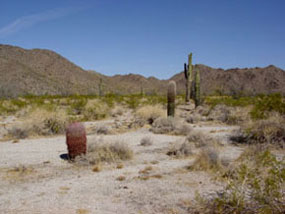 We continued up Highway 60 about 35 miles to Arizona highway 71 stopping frequently along the way. The habitat here consisted of
flat areas separated by hills of volcanic rock. Accompanying the cacti was more Creosote Bush and Ocotillo. The cacti in this area
were Carnegiea gigantea, Cylindropuntia echinocarpa, C. ramosissima, as well as Ferocactus cylindraceus. I didn't notice at the time,
but looking back through the pictures I see that there weren't any Opuntia in that area which are usually the most
common. As we were driving, I was keeping an eye out for a Saguaro with a low-hanging branch or a short one with blossoms.
We continued up Highway 60 about 35 miles to Arizona highway 71 stopping frequently along the way. The habitat here consisted of
flat areas separated by hills of volcanic rock. Accompanying the cacti was more Creosote Bush and Ocotillo. The cacti in this area
were Carnegiea gigantea, Cylindropuntia echinocarpa, C. ramosissima, as well as Ferocactus cylindraceus. I didn't notice at the time,
but looking back through the pictures I see that there weren't any Opuntia in that area which are usually the most
common. As we were driving, I was keeping an eye out for a Saguaro with a low-hanging branch or a short one with blossoms.
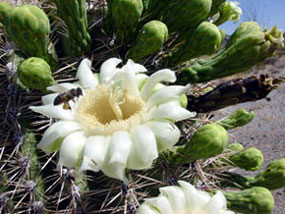 At the first stop that I mentioned above, the flowers were about 10 feet up -too high for me to get a close-up picture. There I
tried to knock down a flower with a small rock so I could get a good picture of just the flower. After throwing and missing about 30 times,
I thought about trying the long stick that was on the ground right next to me. After this stroke of genius, I had a flower in my
hand in a few seconds. This would do for now, but I really wanted a picture of the flower on the plant, not in my hand. Finally,
I spotted a younger Saguaro in bloom that stood about seven feet tall. I stopped again and headed over to get my pictures. I am exactly
6 feet tall and so I had to hold the camera above my head to get the pictures. Of course, one of the benefits of digital cameras
is the ability to preview the pictures immediately. I had to take several shots to get one that was in focus and with the right
composition. As I was doing this, I noticed that there were hundreds of honey bees and other insects swarming all over the flowers.
It was on accident that I captured the moment you see in the picture above of a pollen-laden honey bee comming in for a landing.
You can see some of the other small insects crawling on the petals.
At the first stop that I mentioned above, the flowers were about 10 feet up -too high for me to get a close-up picture. There I
tried to knock down a flower with a small rock so I could get a good picture of just the flower. After throwing and missing about 30 times,
I thought about trying the long stick that was on the ground right next to me. After this stroke of genius, I had a flower in my
hand in a few seconds. This would do for now, but I really wanted a picture of the flower on the plant, not in my hand. Finally,
I spotted a younger Saguaro in bloom that stood about seven feet tall. I stopped again and headed over to get my pictures. I am exactly
6 feet tall and so I had to hold the camera above my head to get the pictures. Of course, one of the benefits of digital cameras
is the ability to preview the pictures immediately. I had to take several shots to get one that was in focus and with the right
composition. As I was doing this, I noticed that there were hundreds of honey bees and other insects swarming all over the flowers.
It was on accident that I captured the moment you see in the picture above of a pollen-laden honey bee comming in for a landing.
You can see some of the other small insects crawling on the petals.
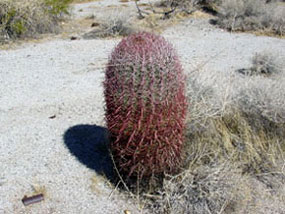
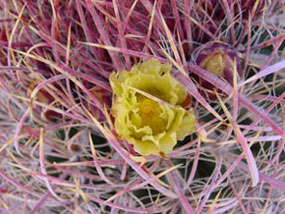
Ferocactus cylindraceus was found growing here among the Saguaros and was also in bloom. Getting pictures of the lemon-yellow
flowers of this plant was no challenge as many were around 3 feet high. I find it interesting how the flowers of many
Ferocacti including this one have to fight their way up through the thick and stiff spines. Ferocactus cylindraceus is another
cactus that also grows in many places of the Mojave desert in California. I saw many of these along the road on the way to Arizona. This and
the other Ferocacti which have been given the common name of "Barrel Cactus" are the mythical source of water for unfortunate desert
travelers. I say mythical for two reasons. First there is not a reservoir of water within these plants that needs only to be tapped
to pour out like a faucet. Secondly, if you were to extract water from these plants by mashing the pulp, you would find it is too
alkaline to be of any benefit. In reality, it would make you worse off than before -much like drinking sea water. So if you
ever find yourself wandering in the desert where Ferocacti live, pass them up and go for the Opuntia instead. The Prickly Pears after
all do contain moisture that you can benefit from.
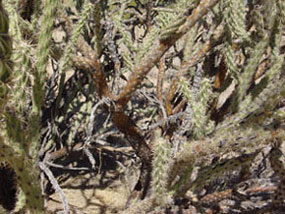
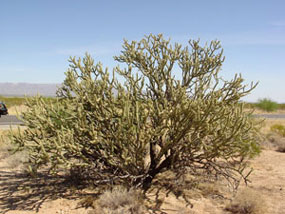
Let's pause again before talking more about Prickly Pears and take a look at a third Cylindropuntia. I found this about 20 miles further
up Arizona highway 71. This time the species is Cylindropuntia acanthocarpa also known under the common name, Buckhorn Cholla. This
species looks similar to Cylindropuntia versicolor which also grows in Southern Arizona. The easiest way to tell them apart is by the
fruit. C. acanthocarpa has spiny fruit and C. versicolor does not. Supposedly C. acanthocarpa can have yellow to orange to dark red
flowers, but I've only seen yellow ones in person. I encountered this plant in bloom later on and it can be seen further down in the article.
Incidentally, the plant in the picture above is around 6 feet high.
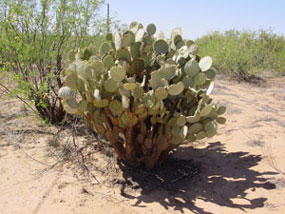 Just a little ways further up the road, I noticed some nice Opuntia chlorotica. Because of the round flat pads, this
species has the common name of Pancake Prickly Pear. I was unsure of the ID of this plant at first because and mistook it for O. santa-rita.
This plant had some purple around the edge of the pads, but was primarily light green. The
very circular pads grow one on top of the other. This growth habit gives the plant the appearance of a bouquet that has been
neatly arranged for a table-top somewhere. It is reported that they can reach up to 6 feet in height. The one you
see here is closer to 4½ feet tall.
Just a little ways further up the road, I noticed some nice Opuntia chlorotica. Because of the round flat pads, this
species has the common name of Pancake Prickly Pear. I was unsure of the ID of this plant at first because and mistook it for O. santa-rita.
This plant had some purple around the edge of the pads, but was primarily light green. The
very circular pads grow one on top of the other. This growth habit gives the plant the appearance of a bouquet that has been
neatly arranged for a table-top somewhere. It is reported that they can reach up to 6 feet in height. The one you
see here is closer to 4½ feet tall.
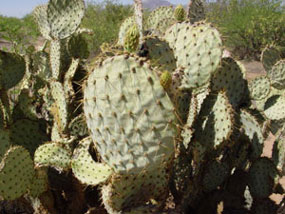 The picture to the left shows a closer view of the pads. By the way, if we are going to continue to talk about Opuntias, then
we might as well use the correct term for the pads which is "cladodes".
The picture to the left shows a closer view of the pads. By the way, if we are going to continue to talk about Opuntias, then
we might as well use the correct term for the pads which is "cladodes".
Looking around a bit more before continuing up
the road, I noticed two clumps of twigs and other debris in one of the Chollas. Upon closer inspection, I realized they were the nests
of Cactus Wrens and one of them was in full use! Standing right next to them at almost eye-level, I was able to get some pictures.
If you look closely in the picture below, you can see one of them hiding as far back as it can get. Not wanting to frighten them too much,
I did not take a picture any closer. On the other hand, they probably didn't realize just how safe they were. I was not about to
start reaching my hand down into the spine-laden Cholla branches! Talk about home security!
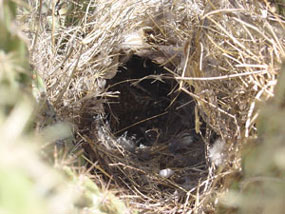
We stopped again just outside
Congress, AZ when the bright pink flower of an Opuntia basilaris caught my eye. I hit the brakes and pulled over. Since the big van
does not exactly "stop on a dime", I had to walk back 60 feet or so to my target. I was glad I did because I walked right up to the
fourth cholla of the trip; Cylindropuntia leptocaulis. This cactus bears the appropriate common name of Christmas Cholla because of the
green and red fruits that decorate the branches year-round. The fruits start out green at the end of summer and ripen to red
through the winter. Very slender, stick-like stems with lots of branches and branchlets make this Cylindropuntia hard to spot. Had I walked
straight from the road up to the O. basilaris that I was after, I no doubt would have missed this Cholla all together; dismissing
it as another creosote bush or other shrub.
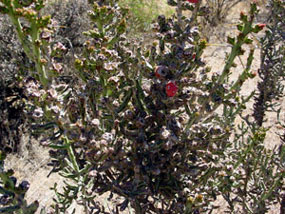
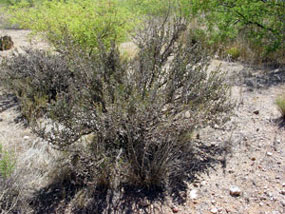 After the unexpected excitement of bumping into the Christmas Cholla, I moved on to
the Opuntia. Opuntia basilaris is the latin name, but it is very well known by it's common name -Beaver Tail Prickly Pear. I have a couple
of these growing in my own collection and they are common not far from where I live. Despite my seeing lots of Beaver Tails, it was
still a thrill to run into one flowering out in the wilds of Arizona. Besides my enjoyment of all cacti, common or not, this particular
Beaver Tail was an exceptional specimen. The main cladode that you see in the center of the plant (lower left picture) measures about
9 inches long! This is about twice the size of most others that I've seen.
After the unexpected excitement of bumping into the Christmas Cholla, I moved on to
the Opuntia. Opuntia basilaris is the latin name, but it is very well known by it's common name -Beaver Tail Prickly Pear. I have a couple
of these growing in my own collection and they are common not far from where I live. Despite my seeing lots of Beaver Tails, it was
still a thrill to run into one flowering out in the wilds of Arizona. Besides my enjoyment of all cacti, common or not, this particular
Beaver Tail was an exceptional specimen. The main cladode that you see in the center of the plant (lower left picture) measures about
9 inches long! This is about twice the size of most others that I've seen.

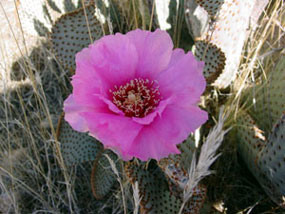
Across the road in this same area, another Opuntia was in bloom. This species is O. engelmannii and it has yellow flowers.
O. engelmannii, also known as Engelman's Prickly Pear, is one of the more widespread of the opuntias in the Southwest and
certainly one of the most variable. Often, this species is identified by ruling out the species that it is not; ruling out the species
it isn't and finally resorting to O. engelmannii as the name. As a result, this name probably gets applied to the wrong
plants all too often.
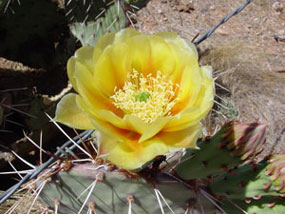
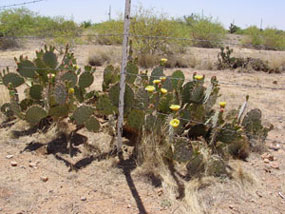
A little further up the road, Arizona Hwy 71 ends at the town of Congress and junction of Arizona Hwy 89. As we continued
another few miles along, I spotted small, brushy Chollas that appeared to be covered with yellow flowers. I hit the
brakes again and jumped out to get some pictures. When I got closer, I could see that the flowers were actually the
bright-yellow fruit of Cylindropuntia imbricata. If it had been flowering season, I would have been stopped
by dark-pink to red flowers, not the yellow of the fruit. I would have really like to see these in flower, but no
complaints from me as these little plants were still very appealing to a cactus nut like me.
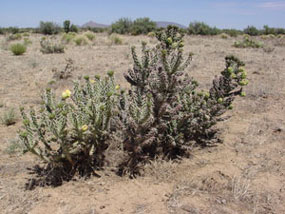
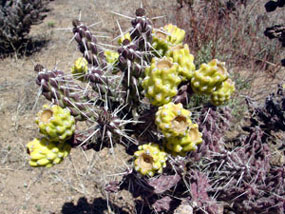
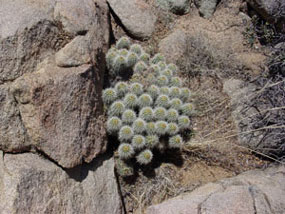 Very soon after leaving the flat land where the C. imbricata was growing, AZ 89 begins a steep ascent of almost 2000
feet in about 4 miles. The road is one curve after another and the two-way road even has to split in places as there is not
enough room for both lanes to be side by side. Bikers seem to like driving on this and congregate in Yarnell at the top of
the hill where fuel prices are higher than more mainstream cities. Part ways up "Yarnell Hill" as it is called,
I got out to see if any cacti grew there. From the road, one could only see various shrubs, with the most conspicuous being
the smooth, red Manzanita. After scrambling around the brush and boulders, I found what I was looking for -another cactus
species. This time it was Echinocereus coccineus which has received several unreliable common names including
"Arizona Hedgehog". This species often forms large clumps and here I found clumps in excess of 50 stems. Later
on I found more of the same species, but with fewer stems per clump. The plants I found here were not blooming, but
the later, smaller clumps were in bloom and those are shown later in this article.
Very soon after leaving the flat land where the C. imbricata was growing, AZ 89 begins a steep ascent of almost 2000
feet in about 4 miles. The road is one curve after another and the two-way road even has to split in places as there is not
enough room for both lanes to be side by side. Bikers seem to like driving on this and congregate in Yarnell at the top of
the hill where fuel prices are higher than more mainstream cities. Part ways up "Yarnell Hill" as it is called,
I got out to see if any cacti grew there. From the road, one could only see various shrubs, with the most conspicuous being
the smooth, red Manzanita. After scrambling around the brush and boulders, I found what I was looking for -another cactus
species. This time it was Echinocereus coccineus which has received several unreliable common names including
"Arizona Hedgehog". This species often forms large clumps and here I found clumps in excess of 50 stems. Later
on I found more of the same species, but with fewer stems per clump. The plants I found here were not blooming, but
the later, smaller clumps were in bloom and those are shown later in this article.
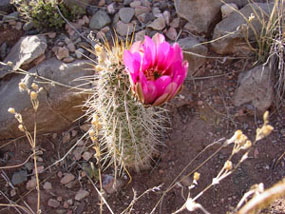 Time was running short as we were due in Cottonwood, AZ for lunch and after fueling in Yarnell with the expensive fuel,
we did not stop again until reaching our destination. This means the 75 miles or so between Yarnell and Cottonwood, I did
not have a chance to explore. I am sure there would have been some smaller cacti in that area had I had a chance to
look for them. The elevation there is over 5000 feet and so temperatures are lower and the desert gives way to
Ponderosa Pine forests. After eating, I did do a little backtracking up Alt AZ 89 not far from the town of Jerome, AZ.
Here I found several more species including Echinocereus boyce-thompsonii, which can be seen here in flower.
Time was running short as we were due in Cottonwood, AZ for lunch and after fueling in Yarnell with the expensive fuel,
we did not stop again until reaching our destination. This means the 75 miles or so between Yarnell and Cottonwood, I did
not have a chance to explore. I am sure there would have been some smaller cacti in that area had I had a chance to
look for them. The elevation there is over 5000 feet and so temperatures are lower and the desert gives way to
Ponderosa Pine forests. After eating, I did do a little backtracking up Alt AZ 89 not far from the town of Jerome, AZ.
Here I found several more species including Echinocereus boyce-thompsonii, which can be seen here in flower.
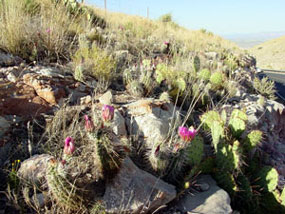
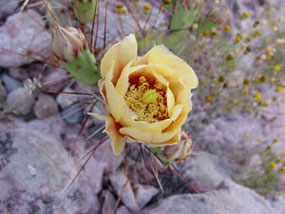
The E. boyce-thompsonii was growing along the rocky roadside which was steep with loose rocks. As I climbed around
taking pictures, at one point I fell and scraped up my hand. A small price to pay to get these habitat shots. Two Opuntia
species were growing here as well. One species we had already seen -that is O. engelmannii (not pictured here) and the
other was also blooming and a new species - Opuntia phaeacantha. This is another widespread and highly variable
Opuntia species that has consequently received numerous common names like Brown-Spined Prickly Pear,
Purple-Fruited Prickly Pear, and Yellow-Spined Prickly Pear. This is a good example why common names are just not
useful for cacti.
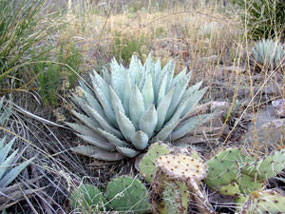
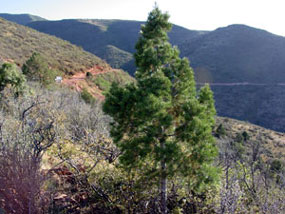
Continuing up past the town of Jerome, we headed out on a little dirt road that went out into the hills. The habitat as
seen above included Agave parryi and Piñon Pines (Pinus edulis). The elevation is around
5,000 feet. As is typical of higher elevation, the cacti here were smaller than the lower elevations. And it is here we
found the smallest of Chollas - Cylindropuntia whipplei referred to as "Whipple's Cholla". These tiny little
plants were no more than 6 inches high and grew among the weathering red sandstone.
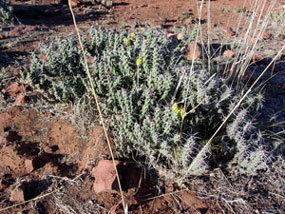

This area was the second place that I encountered Echinocereus coccineus and as mentioned above, this time
the clumps had fewer stems, but were in flower. Sometimes this species is almost completely hidden by a mass of red
flowers. This time it was either not a good year or not the right time of year to see such a display. Despite that
fact, I was completely thrilled to find even one flower.
The next day, we did not spend as much time in Cactus country and went to Oak Creek and the town of Sedona, AZ. However,
we did encounter one cactus species when we took a drive up Schnebly Hill Road. This road is a very rough dirt road that
winds up the hills above Sedona. It is a road better suited for vehicles with four wheel drive, if not at least high
clearance. We had no problem with this. When we got to the top of the hill, I got out and explored for cacti. I soon
discovered that this was prime habitat for Escobaria vivipara. This species was growing all over the volcanic
rock outcroppings. Many of them seemed to be growing right out of pure rock. Some of them were solitary plants up to
3 inches across, while others formed small clumps. Unfortunately, we were just a little too early to see the flowers.

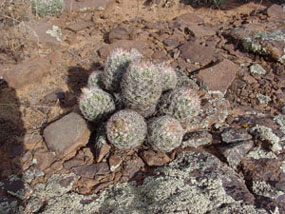
With just the single species to report for the previous day, we were back on the road again for the third and final day.
This time, cacti were plentiful. Leaving Cottonwood, we went down the 17 Freeway to just north of Phoenix where we cut
across on the "Carefree Highway" - AKA Arizona 74 towards Morristown. Here we encountered mass amounts of
Chollas.
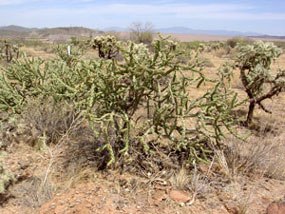
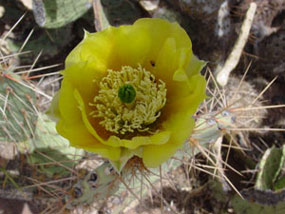
The first Cholla we saw was another Cylindropuntia acanthocarpa only this time they were in flower. The C. acanthocarpa
here were also smaller than those we saw further west. Another Cholla in flower here was Cylindropuntia bigelovii;
affectionately known as "Teddy Bear Cholla". While the common name sounds like something you want to embrace,
this cactus is quite possibly, the last one you'd want to touch. The dense spines of this species are extremely sharp and
each spine contains reverse barbs up and down the surface. In addition, the stem joints break of easily and when you pull
away, the joint comes along with you. Pulling the spines out slowly is excruciating and a quick yank is the best method.
While this is still quite painful, it is at least quick. I had never seen C. bigelovii in bloom before and when
I first spotted the translucent silky green flowers for the first time I let out an audible "Whoo hoo!" For
such a vicious cactus, the flowers were sure delicate.
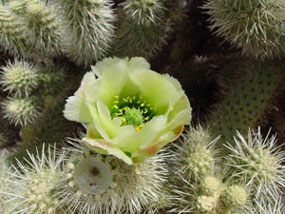
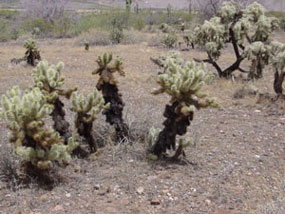
In this area also grows another "Barrel Cactus" referred to as "Arizona Barrel Cactus" with the latin
name of Ferocactus wislizeni. Like the F. cylindraceus that I encountered at the beginning of this
trip, the F. wislizeni were also in bloom.
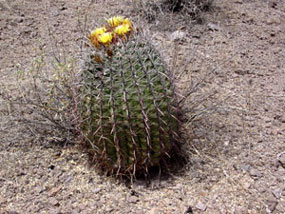
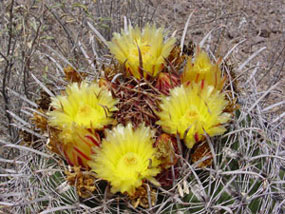
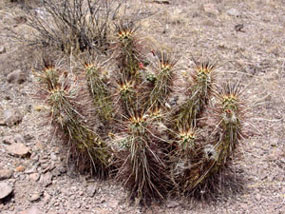
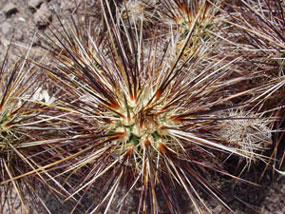
In association with the Ferocactus, another species of Echinocereus was growing - E. engelmannii. This
species is as variable as one cactus can be and as a result most taxonomists don't bother trying to sort through them.
The plant pictured above had the most incredible spines of any cactus I have seen. As we drove along the "Carefree
Highway", we made frequent stops. It was hot, in the 90's F, but not as hot as it would be later in the summer. All
around I saw Saguaros, Chollas, Ferocactus, and Echinocereus. Every so often, I would come across a Ferocactus that was
uprooted.(see below) I don't know what it is that caused this. My best guess is that a sudden/heavy rain storm washes the
loose desert soil away from the roots and because these cacti grow leaning towards the south, they simply tip over. I did
note that they were all tipped over facing the south.
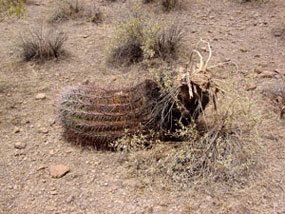
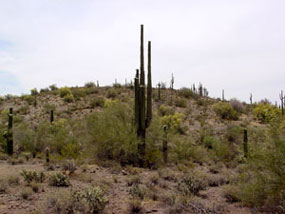
Along with the cacti, many of the associated desert plants were flowering too. Among them were the yellow-flowered Palo Verde
(Cercidium floridum -above right) and the pink flowered "Desert Ironwood" (Olneya tesota -below right). Both of these
species provide shelter for young Saguaros.
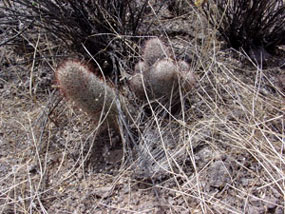
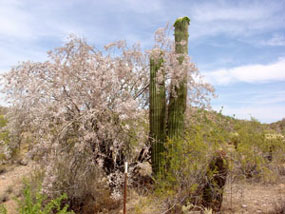
On closer inspection in and among the rocks and shrubs, one can find Mammillaria grahamii which is known as
"Arizona Fishhook Cactus" in the vernacular. (photo above left) This name is appropriate as it is the dominant Mammillaria in
Arizona. It grows as a single stem up to 12 inches long or forms small clumps. Like many Mammillarias, it has a hooked
central spine which is why they are referred to as "Fishhook Cactus". At the same time there are other cacti
genera that feature hooked spines and this alone is not a reliable ID.
At this point, I had figured the cactus sighting was past and it was time to head straight for home. As I was driving along
U.S. HWY 60, however, one more cactus caught my eye. I hit the brakes and jumped out with camera in hand. From a
distance, a casual observer would not even notice this species, but I know right away that it was a Grusonia. These heavily
armoured cacti grow in mats low to the ground. This has earned them the common name "Ground Matt Cholla" although
they have never been considered a Cylindropuntia (Cholla).
While I knew this was a Grusonia, it wasn't until
I got home that I figured out it was Grusonia parishii.
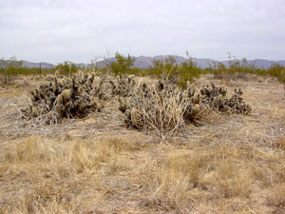

All in all it was a fantastic trip. In the short space of a few days, I found over 20 species of cacti. Few places can
boast of such a rich variety of cacti as Arizona. And what we saw on our quick loop through the central part of the
state was just a sampling of the many species that can be found there. I have been fortunate to have made other visits
to this cactus-lovers paradise and many of the images of cacti can be found here on CactiGuide.com. I hope you have
enjoyed coming along with me on this virtual tour of Arizona!
Author: Daiv Freeman
|